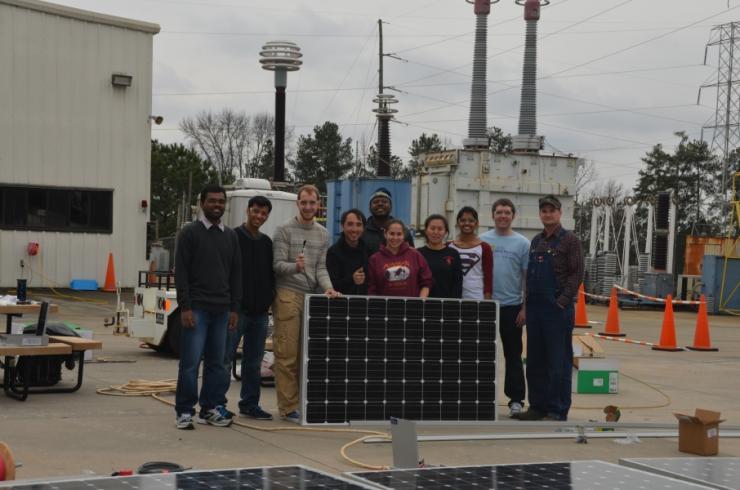Power to the People: Georgia Tech Student Group Brings Electric Power to Remote Haitian Health Center
May 04, 2016 — Atlanta, GA

Access to reliable, cost-effective energy service is essential for supporting quality of life and economic development in communities worldwide. Without electric power even fundamental needs, such as safe drinking water, sanitation, and basic health care cannot be met. But in much of the developing world, electricity generation is non-existent, or at best unreliable. A group of Georgia Tech students aim to improve access to clean, reliable power at a remote health center in one of the poorest countries in the western hemisphere, using a solar-based microgrid.
Microgrids are self-contained power systems that can draw electricity from the traditional grid when available, but can also disconnect and operate as an independent energy source for single businesses or a home. The systems are gaining popularity in the developing world as a means of providing power to areas that do not have stable access to the conventional electric power grid. Georgia Tech’s IEEE Power & Energy Society (PES) Student Chapter, led by electrical engineering graduate students Jeremiah Deboever, Felipe Larrain, Szilard Liptak, and Ashley Stone, plans to install the microgrid system to support a newly-constructed health center in the remote mountain village of Thoman, Haiti. The health clinic, located about 50 miles east of the country’s capital and largest city, Port-au-Prince, provides health and dental care for the more than 4,000 people living in Thoman and surrounding villages.
Even before the 2010 earthquake, Haiti’s power infrastructure and maximum generating capacity of 200 MW was insufficient to meet the country’s peak power demand, said IEEE-PES Faculty Advisor Frank Lambert, a principal research engineer with Georgia Tech’s National Electric Energy Testing Research and Applications Center (NEETRAC).
“Some seven million people in Haiti are without power; only an estimated 25 percent of the population have access to electricity services,” said Lambert. “And in rural communities like Thoman where the majority of Haitians live, the problem is even more challenging because it can be difficult and expensive to reach grid power.”
Power distribution lines were extended last year to connect Thoman to Haiti’s main power grid, but service is so erratic that the health clinic must operate almost exclusively from a diesel generator. Given the high cost and limited access to diesel fuel, the students wanted to develop a more affordable, reliable power solution to meet the health clinic’s needs.
The team evaluated several power generating units, including a standalone diesel generator (DG), photovoltaic (PV) panels with batteries, and the combination of PV panels with batteries and a DG to determine which options would provide the most power at the lowest cost. Each option was evaluated by several technical and economic criteria, such as daily energy production, maximum annual capacity shortage, and net present value. The team also incorporated other factors into their assessment: the system had to be easy to use, big enough to meet the clinic’s future needs, and contain only off the shelf components that could be replaced. The team developed a hybrid microgrid system that included a 7.2 kW PV array and a battery bank to eliminate the need for the diesel generator in day-to-day operations. The diesel generator would only be used to provide backup power when needed.
“A standalone diesel generator would have been cheaper to install than a solar system,” said Liptak, one of the project’s system designers. “But it consumes an incredible amount of fuel, and over the entire lifetime of the project, would have ended up being twice as expensive as the solar solution. An additional benefit of the solar-based system is that it’s clean and maintenance is minimal.”
After nearly a year of design, basic and detailed engineering that included a site visit to Thoman to test and validate the solar design, the team will install the microgrid in Thoman in May. Students secured donations from corporate sponsors to fund 100 percent of the project. The microgrid’s PV solar panels were provided by the Georgia Tech Research Institute; local companies Trojan Battery Company and Schneider Electronics provided the battery pack and the power electronics, respectively. The costs of shipping the microgrid components to Haiti were provided by But God Ministries.
For system designer Larrain, a Ph.D. student specializing in organic solar technologies in Georgia Tech’s Center for Organic Photonics and Electronics, the project provided a real-world context for the work he does every day.
“As a Ph.D. student, my mind is typically focused on understanding the science behind the operation of these devices,” said Larrain. “I rarely see the customer side of solar energy-based solutions or get into the details of practical applications. This project provides a great complement to what I do by exposing me to a direct application of the technology I want to improve, and really highlights how, in the end, any technology that we develop is intended for a customer, to solve a very specific need.”
Liptak, who recently returned to Georgia Tech from an internship with a microgrid company in Kenya, said that microgrids have great potential in the electrification of the developing world.
“With the growing penetration of renewable technologies and distributed generation with storage, these local microgrids could one day form a national grid similar to what we have in the developed world,” said Liptak.
The IEEE PES Student Chapter hopes to build upon the experience gained from the Thoman microgrid project to develop a similar power generation and distribution system for another health center of Galette Chambon, Haiti next year.
Story written by Allison Caughey, formerly of the Georgia Tech Strategic Energy Institute




